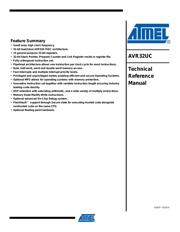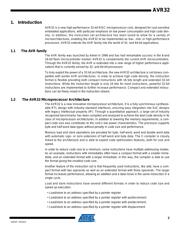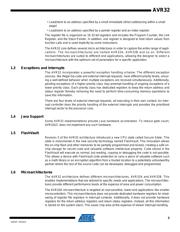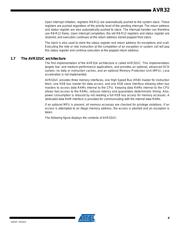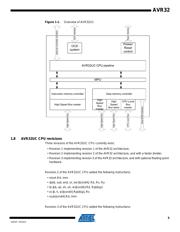Datasheet 搜索 > 微控制器 > ST Microelectronics(意法半导体) > STM32F412RET6 数据手册 > STM32F412RET6 产品设计参考手册 3/159 页

 器件3D模型
器件3D模型¥ 11.753
STM32F412RET6 产品设计参考手册 - ST Microelectronics(意法半导体)
制造商:
ST Microelectronics(意法半导体)
分类:
微控制器
封装:
LQFP-64
描述:
STM32F412RET6可运行于工作频率100 MHz、支持浮点运算单元的Cortex-M4内核,在运行和停机模式下实现出色的低功耗性能。
Pictures:
3D模型
符号图
焊盘图
引脚图
产品图
页面导航:
原理图在P88
功能描述在P136
应用领域在P89
导航目录
STM32F412RET6数据手册
Page:
of 159 Go
若手册格式错乱,请下载阅览PDF原文件

3
32002F–03/2010
AVR32
• Load/store to an address specified by a small immediate (direct addressing within a small
page)
• Load/store to an address specified by a pointer register and an index register.
The register file is organized as 16 32-bit registers and includes the Program Counter, the Link
Register, and the Stack Pointer. In addition, one register is designed to hold return values from
function calls and is used implicitly by some instructions.
The AVR32 core defines several micro architectures in order to capture the entire range of appli-
cations. The microarchitectures are named AVR32A, AVR32B and so on. Different
microarchitectures are suited to different end applications, allowing the designer to select a
microarchitecture with the optimum set of parameters for a specific application.
1.3 Exceptions and Interrupts
The AVR32 incorporates a powerful exception handling scheme. The different exception
sources, like Illegal Op-code and external interrupt requests, have different priority levels, ensur-
ing a well-defined behavior when multiple exceptions are received simultaneously. Additionally,
pending exceptions of a higher priority class may preempt handling of ongoing exceptions of a
lower priority class. Each priority class has dedicated registers to keep the return address and
status register thereby removing the need to perform time-consuming memory operations to
save this information.
There are four levels of external interrupt requests, all executing in their own context. An inter-
rupt controller does the priority handling of the external interrupts and provides the prioritized
interrupt vector to the processor core.
1.4 Java Support
Some AVR32 implementations provide Java hardware acceleration. To reduce gate count,
AVR32UC does not implement any such hardware.
1.5 FlashVault
Revision 3 of the AVR32 architecture introduced a new CPU state called Secure State. This
state is instrumental in the new security technology named FlashVault. This innovation allows
the on-chip flash and other memories to be partially programmed and locked, creating a safe on-
chip storage for secret code and valuable software intellectual property. Code stored in the
FlashVault will execute as normal, but reading, copying or debugging the code is not possible.
This allows a device with FlashVault code protection to carry a piece of valuable software such
as a math library or an encryption algorithm from a trusted location to a potentially untrustworthy
partner where the rest of the source code can be developed, debugged and programmed.
1.6 Microarchitectures
The AVR32 architecture defines different microarchitectures, AVR32A and AVR32B. This
enables implementations that are tailored to specific needs and applications. The microarchitec-
tures provide different performance levels at the expense of area and power consumption.
The AVR32A microarchitecture is targeted at cost-sensitive, lower-end applications like smaller
microcontrollers. This microarchitecture does not provide dedicated hardware registers for shad-
owing of register file registers in interrupt contexts. Additionally, it does not provide hardware
registers for the return address registers and return status registers. Instead, all this information
is stored on the system stack. This saves chip area at the expense of slower interrupt handling.
器件 Datasheet 文档搜索
AiEMA 数据库涵盖高达 72,405,303 个元件的数据手册,每天更新 5,000 多个 PDF 文件
